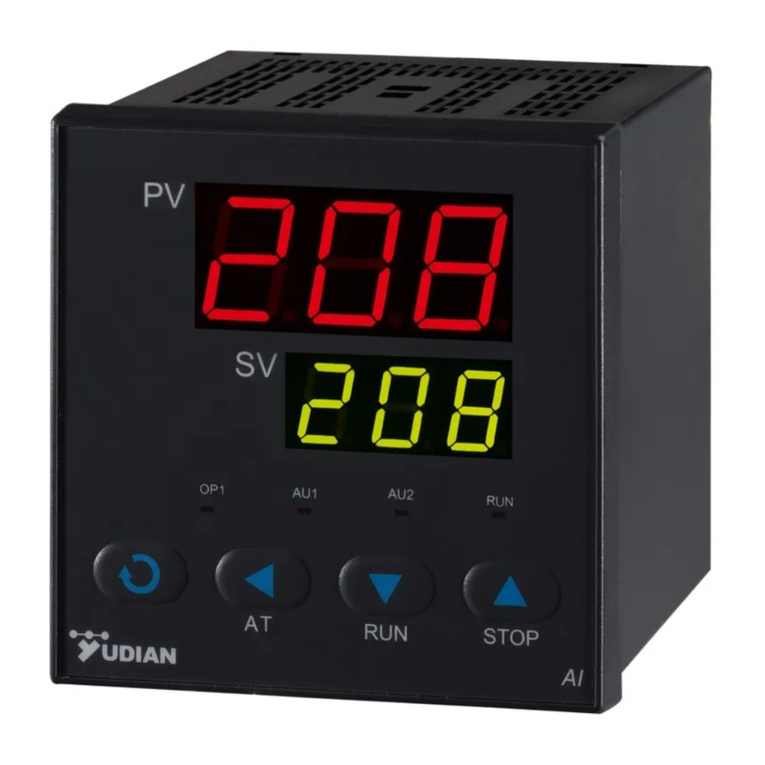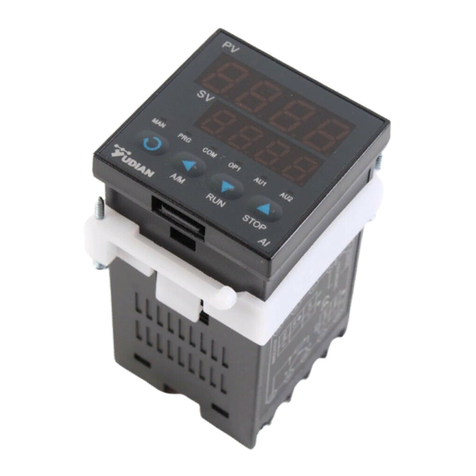
9. Advance Function
Alarm blocking at the beginning of power on
Sometimes the fault alarm may occur at the
beginning of power on. In a heating system, at the
beginning of power on, its temperature is much low-
er than the set point. If low limit and deviation low
limit are set and the alarm conditions are satised,
the instrument should alarm, but there is no prob-
lem in the system. Contrarily, in an refrigerating
system, the unnecessary high limit or deviation high
limit alarm may occur at the beginning of power
on. erefore, AI instruments oer the function of
alarm blocking at the beginning of power on. When
Act is set to rEbA or drbA, the corresponding low
or high alarms are blocked until the alarm condition
rst clears. If the alarm condition is satised again,
the alarm will work.
Communication function
S or S4 module can be installed at COMM slot to
communicate with a computer. e instrument can
be controlled by computer. AI instruments can be
connected to the computer through RS232 or USB
communication port. Every communication port of
a computer can connect up to 60 AI instruments,
or 80 AI instruments if a repeater is installed. A
computer with 2 communication ports can connect
up to 160 instruments. Please note that every instru-
ment connecting to the same communication line
should be set to a unique communication address.
If the number of instrument are enough, 2 or more
computers can be used and a local network can be
set up.
If users want to develop their own distributed
control system by themselves, the communication
protocol of AI instruments can be freely oered.
ere are many distributed control system soware
support AI instruments.
Fine control
Fine control means that the PID operating reso-
lution is ten times as high as the display resolu-
tion. For example, the temperature signal of the
instrument displays 1°C, but the internal PID still
operate and control as per 0.1°C resolution, thus can
realize the control accuracy much higher than the
display resolution. In former AI series instruments,
only temperature signal adopts ne control mode.
e new edition approves default ne control mode
when the displayed value range is below 3,000 char-
acters (on most of industrial application occasions,
the value should not exceed 3,000 characters) during
linear input, so as to get higher control accuracy and
more stable output. When the required display value
range is larger than 3,000, AF.F=1.
User-defined input specifications
When INP is set to 64 larger than preset value, the
input specication of the instrument switches to
user-dened input. Set INP=22+64=86. e linear
table can be edited, the setup method is as follows:
set Loc parameter as 3698, and then enter the table
setup status (if the original Loc=808, the Loc shall
be zeroed, exit the parameter setting status, and then
reenter the parameter setting status and set Loc as
3698). Of which the parameter A 00 denes the use
of the table, 0 is used to input non-linear measuring,
1 is used to high temperature furnace non-linear
control, with parameters of A01~A04 and d00~d60
respectively set as follows:
A 00=0 (xed)
A 01 denes input speccation
Formula: A 01=A*1+E*16+G×*64
A is the range of measurement:
A=0: 0~20mV (0-80Ω);
A=1: 0~60mV (0-240Ω);
A=2: 0~100mV (0-400Ω);
A=3: 0~1V;
A=4: 0~5V,
A=10, 0~20mA or 0~10V (MIO position installed with I4 or I31
module)
E=0: Output value still should be determined as per ScH/ScL parame-
ters during linear input of signals.
E=1: e table output value is the displayed value.
G is the type of sensor.
G=0: thermocouple;
G=1: thermal resistance;
G=2: linear voltage (current);
G=3: linear resistance
For instance: Pt100 input; range 30~40oC; every adjustment section
at one degree
Long press Setup. Set inP=86. Set dPt=0.0.
LOC=3698 (Enter user-dened multi-section adjustment)
A00 = 0
A01 = 82 (Function setup. Set Pt100 conguration 82)
A02 = 300.0 (Initial temperature at 30oC)
A03 = 100.0
A04 = 10.0
d00 = 30.00 d01 = 31.00 d02 = 32.00
d03 = 33.00 d04 = 34.00 d05 = 35.00
d06 = 36.00 d07 = 37.00 d08 = 38.00
d09 = 39.00 d10 = 40.00
Set the deivation directly to the particular temperature. If it is show-
ing 37oC but it is found higher, set d07 a little bit lower than 37.00.
YUDIAN Automation Co., Limited
YUDIAN (H.K) Automation Co., Limited
12/F, Chun Hoi Commercial Building, 688 Shanghai Street,
Kowloon, Hong Kong
http://www.yudian.com.hk
































